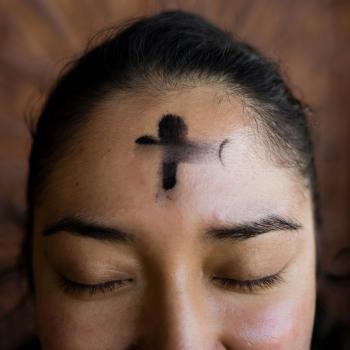 In the Slavic tradition, October 1st is an important, and well-loved, Marian Feast: The Protection of the Mother of God. In the Blachernae church near the entrance of Constantinople, relics owned by the Theotokos were housed, including her robe, veil, and a part of her belt. On the evening of October 1, in the 10thcentury, St Andrew the Fool for Christ saw an apparition of the Theotokos as she came down from the air and into that church, whereupon she knelt down and beseeched God in prayer. Afterwards, she took heir veil and had it spread over all the people, and the church, as a sign of protection. When St Andrew asked his disciple, St Epiphanius, if he saw the Mother of God, Epiphanius confirmed the vision. And from that event, the city of Constantinople was given protection from outside forces. There is a sense of irony to this, however: while the Greeks kept the feast, they did so only as long as Constantinople remained, but once it fell to the Turks, their connection with the feast dwindled. On the other hand, the Slavs remembered the day and it became one of the great Slavic feasts, despite the fact that, according to their own tradition, Mary had protected the city from a Rusian fleet.[1]
In the Slavic tradition, October 1st is an important, and well-loved, Marian Feast: The Protection of the Mother of God. In the Blachernae church near the entrance of Constantinople, relics owned by the Theotokos were housed, including her robe, veil, and a part of her belt. On the evening of October 1, in the 10thcentury, St Andrew the Fool for Christ saw an apparition of the Theotokos as she came down from the air and into that church, whereupon she knelt down and beseeched God in prayer. Afterwards, she took heir veil and had it spread over all the people, and the church, as a sign of protection. When St Andrew asked his disciple, St Epiphanius, if he saw the Mother of God, Epiphanius confirmed the vision. And from that event, the city of Constantinople was given protection from outside forces. There is a sense of irony to this, however: while the Greeks kept the feast, they did so only as long as Constantinople remained, but once it fell to the Turks, their connection with the feast dwindled. On the other hand, the Slavs remembered the day and it became one of the great Slavic feasts, despite the fact that, according to their own tradition, Mary had protected the city from a Rusian fleet.[1]
Most holy Mother of God, today we Orthodox joyfully celebrate thy coming among us. As we gaze at thy icon we cry with compunction: Shelter us under thy protection, deliver us from evil, and pray thy Son Christ our God to save our souls (Troparion of the Protection).
The significance of the day is not exclusive to history; rather, the theological implications of the Protection point to the role Mary has in the ongoing Theo-Drama, of which we find ourselves a part. She is always there, praying for us, interceding for us, showing us her love, working for our well-being, both spiritual and physical. Mary as the Theotokos always presents to us an image of the incarnate nature of God’s work: through her God is made flesh, allowing the flesh to be saved. Christ came to heal us, not only as spiritual entities, but as concrete, fleshy people who exist in bodily form. Our physical welfare is as much a concern for God as is our spiritual health. It was not an accident that led Christ to physically heal those around him; it was a necessary function of his mission as savior of humanity. The flesh reveals, in part, the character of the soul; Christ’s healing of people’s physical ailments manifested the truthfulness of his claim to heal the soul. If the body is made whole, who is to judge him when he said someone’s sins are forgiven? “When Jesus perceived their questionings, he answered them, ‘Why do you question in your hearts? Which is easier, to say, `Your sins are forgiven you,’ or to say, `Rise and walk’? But that you may know that the Son of man has authority on earth to forgive sins’ — he said to the man who was paralyzed – ‘I say to you, rise, take up your bed and go home.’ And immediately he rose before them, and took up that on which he lay, and went home, glorifying God” (Luke 5:22 – 25).
Mary, our holy Mother, continues to intercede for us, continues to make sure we are shown Christ’s loving grace; we continue to be protected by her intercession, for she makes sure that our daily lives, no matter how sorrowful they are, are nonetheless capable of being penetrated by the grace of her Son, Jesus, that our lives can be lived out in victory and not defeat. No matter what circumstances throw to us, no matter how terrible our situation becomes, we do not have to be defeated. Things could be worse. We are protected so that whatever we face, no matter how difficult it is (and yes, it can be terrible), through the grace of God we can preserve. “No temptation has overtaken you that is not common to man. God is faithful, and he will not let you be tempted beyond your strength, but with the temptation will also provide the way of escape, that you may be able to endure it” (1 Cor. 10:13). We should not mistake this as suggesting life will be easy. It won’t be. Life in fact will, for most of us, have times where it seems as if we can’t continue. The suffering will seem unbearable. The suffering can seem to go on for way too longer. We can, like the prophets of old, mourn for what we experience in life. It can seem as if there is nothing left for us – and yet, we push on, we continue. We don’t give up. And we find, beside us, Mary, sheltering us in her love, taking the full blunt of the burden we have in life, taking more of it than even that which we experience. “The crucified soul languishes in the forsakenness by God on the cross. But the world is not forsaken in sorrow. Man is not alone in his pain. The maternal heart is wounded and torn: together with us, the Mother of God weeps over us. The tearful prayer of the Most Pure One is a prayer with us and for us.”[2]
That which we think is beyond our ability to accomplish is beyond our ability when left to ourselves. If left to our own devices, we would indeed forsake God in times of trial. But we are not left alone. We have the grace of God administered to us through the gracious intercession of the Theotokos. There, we find joy, even in the midst of our sorrow. There we find strength, even in our weakness. There we find healing, even for our wounded life. That is, she is the mediatrix of graces, if one understands this properly. “Today the Virgin is standing before us in the Church/ praying for us with the choirs of Saints. Angels worship with Hierarchs, Apostles rejoice with Prophets, for the Mother of God intercedes with the Eternal God for us” (Kontakion of the Protection).
All of this can be seen symbolized in traditional images of the Theotokos: she is clothed in a blue robe and a red (or sometimes, violet), veil. “Blueness, as is well known, symbolizes air, sky, and therefore the presence of Divinity in the world through His creativity, through His powers.”[3] The blue robe, representing the heavens, presents to us an image of the divinity that was placed in her womb: “heaven was brought down to earth and the Word Himself was fully contained in” her.[4] Of her veil, much has also been said: “Mary wears the maphorion over her dress; this maphorion encircles her head and is often called Pokrov, veil. It has a previous golden border and is ornamented with three stars, one above the forehead and two others on the shoulders. These are the signs of her perpetual virginity.”[5] Her very personality, as presented in her iconographic representation, combines her human, but all so perfectly pure, character with the work of her divine son; she is clothed in majestic and ever-fruitful virginity. She is the mother of sorrow and the mother of joy in one, even as she is clothed in a heavenly-blue robe and a blood-red veil. And in her person we find the greatest intercessor for our behalf, because she experienced the sharp pain of the death of her son in a way no one else can, making the joy she experiences in the resurrection equally unique. Her very person is tied to her son: his sorrow is her sorrow, his pain is her pain. “And Simeon blessed them and said to Mary his mother, ‘Behold, this child is set for the fall and rising of many in Israel, and for a sign that is spoken against (and a sword will pierce through your own soul also), that thoughts out of many hearts may be revealed’” (Luke 2:34-35). Her tears over the death of her son are mingled with the tears she sheds on our behalf, providing us great hope, for we know that at the end of her sorrow, there is joy, the joy of the resurrection.
Footnotes
[1] The only problem with this is that the Protection was to take place in the 10thcentury, but the Rusian fleet seems to have been destroyed in the 9th.
[2]Sergius Bulgakov, Churchly Joy. Trans. Boris Jakim (Grand Rapids, MI: William B. Eerdman’s Publishing Company, 2008), 12.
[3]Pavel Florensky, The Pillar and Ground of the Truth. trans. Boris Jakin (Princeton: Princeton University Press, 1997), 390.
[4]Cf. Akathist Hymn, First Chant.
[5]Paul Evdokimov, The Art of the Icon: A Theology of Beauty. trans. Steven Bigham (Redondo Beach, CA: Oakwood Publications,1996), 265.












